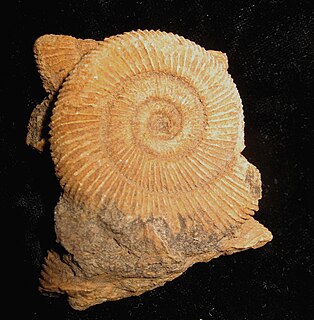
Dactylioceras was a widespread genus of ammonites from the Lower Jurassic period, approximately 180 million years ago (mya).
Zugodactylites is an extinct genus of ammonite cephalopod from the lower Toarcian epoch of the Lower Jurassic, ammonite zone Fibulatum. Its fossils are found in Europe, Russia and Canada.
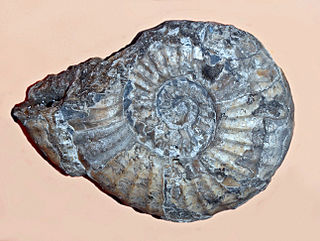
Psiloceratoidea is a superfamily of Early Jurassic ammonoid cephalopods proposed by Hyatt in 1867, assigned to the order Ammonitida. They were very successful during Hettangian and Sinemurian. Last of them, family Cymbitidae and genera Hypoxynoticeras and Radstockiceras survived into Early Pliensbachian.

Harpoceratinae is an extinct subfamily of cephalopods belonging to the family Hildoceratidae. Ammonites of this subfamily had involute and compressed shells with strong keels. Keel might be rarely missing, but this is considered to be an abnormality. This has been observed both in Cleviceras and Harpoceras and called as genus Monestieria, which is now known to be invalid. Another example is Pseudolioceras, whose unkeeled specimen was used as type for description of invalid genus Praehaploceras. Oxyconic forms of this subfamily does not have any keel. Ribs were single, but in some genera also bifurcating with shapes from sigmoidal to falcate. Sometimes, shell can have only striate ribs or is smooth. Tubercules are rare. Dimorphism is known in some genera and it is observable mostly in size. Macrochons can be 4, to 6 times larger than microconchs. As an example, macroconchs of Pseudolioceras are more than 150mm in diameter, while adult microconchs are only 35-50mm. There are big size differences even within dimorphs. Specimens ca be 2, or sometimes even 3 times bigger than other specimens of same dimorph.

Hammatoceras is a genus of ammonites belonging to the family Hammatoceratidae which lived during the Late Toarcian stage of the Early/Lower Jurassic between about 184 and 175 million year ago.
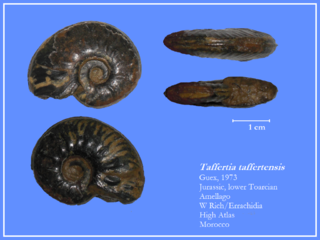
Taffertia is an extinct genus of cephalopod belonging to the family Hildoceratidae. These cephalopods existed in the Jurassic period, during Toarcian age in the Falciferum zone and possibly only in Exaratum subzone. Its fossils were found in Canada, Morocco, Algeria and Italy
Ovaticeras is an extinct genus of cephalopod belonging to the family Hildoceratidae. These cephalopods existed in the Jurassic period, during upper Pliensbachian and lower Toarcian. Its fossils were found in Europe, North Africa and possibly also in Canada and Vietnam. It might have evolved from Harpoceras falciferum and died out without leaving any descendants.

Cleviceras is an extinct genus of cephalopod belonging to the family Hildoceratidae. These cephalopods existed in the Jurassic period, during Toarcian and possibly even uppermost Pliensbachian age. Sometimes, it is considered to be a synonym of Eleganticeras.

Prodactylioceras is genus of ammonite that lived during the Pliensbachian stage of early Jurassic. It has evolved from Reynesocoeloceras, but maybe not directly, but through Bettoniceras. Its fossils were found in Europe, Asia and North America.
Peronoceras is genus of ammonite that lived during the middle Toarcian stage of early Jurassic. Members of this genus existed only in Fibulatum Subzone of Bifrons Zone. Their fossils were found in Europe, northern Africa, Asia, North America and South America.
Porpoceras is genus of ammonite that lived during the early and middle Toarcian stage of early Jurassic. Members of this genus existed from uppermost part of the Harpoceras serpentinum zone to the Haugia variabilis zone. Their fossils were found in Europe, Asia, North America and South America.
Septimaniceras is genus of ammonites that has probably evolved from Peronoceras and lived during the middle Toarcian stage of early Jurassic. Members of this genus existed from Bifrons Subzone to lower part of Variabilis Subzone. Their fossils were found in France, Hungary and probably also in Austria.
Catacoeloceras is genus of ammonite that lived during middle to late Toarcian stage of early Jurassic. Members of this genus existed from Crassum Subzone of Bifrons Zone to Variabilis Zone. Their fossils were found in Europe, northern Africa, Asia, North America and South America. It has evolved from Peronoceras, or Porpoceras.
Neolioceratoides is genus of ammonites that lived during the Pliensbachian and Toarcian stages of early Jurassic. It has been considered to be a synonym of Lioceratoides, but cladistic analysis has shown, that this genus is not only valid, but they even belong to different subfamily, as Lioceratoides belongs to Harpoceratinae. Their fossils were found in Europe and northern Africa.
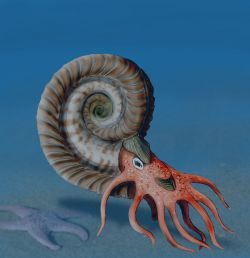
Hildoceratinae is an extinct subfamily of cephalopods belonging to the family Hildoceratidae. Ammonites of this subfamily had shells with elliptical or quadrate whorl section with keel or tricarinate, bisulcate venter. Ribs were variable, from falcate to strongly angled and from fine to strong. They can be interrupted by spiral groove in midlateral part of the shell. While some species can be smooth, strongly ribbed ones can have tubercules. Microconchs have short lapplets that is in its shape similar to the shape of growth lines in spiral midlateral groove.

Orthildaites is a genus of ammonites that lived during the lower Toarcian stage of early Jurassic, during Falciferum subzone.
Parahildaites is genus of ammonites that lived during the lower Toarcian stage of early Jurassic, during Bifrons zone. It differs from Hildaites and Hildoceras by having smooth shell after reaching 4 cm in diameter. There is no spiral groove and on early whorls, there can be sigmoidal ribs or striae. Strong keel is bordered by flat areas or slight sulci. Its fossils were found in Saudi Arabia and Madagascar.
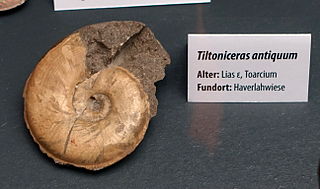
Tiltoniceras is an extinct genus of cephalopod belonging to the family Hildoceratidae. These cephalopods existed in the Jurassic period, from upper Pliensbachian age, Spinatum zone until lower Toarcian, Tenuicostatum zone in what is now Europe, North America and Asian part of Russia.

Dumortieria is a genus of ammonites belonging to the family Hildocerataceae.

Mercaticeras is an extinct genus of ammonites belonging to the family Hildoceratidae.












